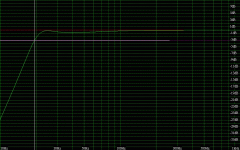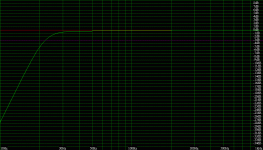Hello everyone, i've finally decided to start my own subwoofer project.
I'll be using the Dayton 10" HF reference http://www.partsexpress.com/pe/showdetl.cfm?&DID=7&Partnumber=295-460
The 3.0 cubic ft. enclosure.
http://www.partsexpress.com/pe/showdetl.cfm?&DID=7&Partnumber=302-820
and the dayton 240 watt amp
http://www.partsexpress.com/pe/showdetl.cfm?&DID=7&Partnumber=300-804
My design will be ported with a tuning frequency of 20-22hz.
This is the WinISD graph.
Is there anything wrong with my design, for example should i change the tuning frequency, try a sealed design, use a different enclosure etc.
This is my first project and i wouldn't want to throw away the money.
Thank You!
I'll be using the Dayton 10" HF reference http://www.partsexpress.com/pe/showdetl.cfm?&DID=7&Partnumber=295-460
The 3.0 cubic ft. enclosure.
http://www.partsexpress.com/pe/showdetl.cfm?&DID=7&Partnumber=302-820
and the dayton 240 watt amp
http://www.partsexpress.com/pe/showdetl.cfm?&DID=7&Partnumber=300-804
My design will be ported with a tuning frequency of 20-22hz.
This is the WinISD graph.
Is there anything wrong with my design, for example should i change the tuning frequency, try a sealed design, use a different enclosure etc.
This is my first project and i wouldn't want to throw away the money.
Thank You!
Attachments
You could lower the tuning frequency because room will increase the bass response down low. It's better to have a slightly decreasing frequency response curve, like 0 dB at 80 Hz decreasing slightly to -4 dB at the tuning frequency. To do that you could use a longer port or a smaller box.
You're using a 10 inches driver with a good amplifier, check the excursion graph, I think your driver doesn't need all that power hehe, but more is better than less, if you can control yourself.
You're using a 10 inches driver with a good amplifier, check the excursion graph, I think your driver doesn't need all that power hehe, but more is better than less, if you can control yourself.
Try a smaller box, the hump will be gone. Then play with the tuning frequency. Maybe you'll need the same one, or lower, or higher.
Good luck!
BTW, that hump isn't that nasty, it's not even half a dB. It's a very small one, acceptable hump. If it was several dBs then ok worry about it hehe!
Good luck!
BTW, that hump isn't that nasty, it's not even half a dB. It's a very small one, acceptable hump. If it was several dBs then ok worry about it hehe!
I'm looking at using that same driver and came up with a smaller box size. Optimal size calculated to 1.90 ft^3 and a 17"x3" vent. I don't have the pieces yet, but the driver+vent+amp will only displace ~0.2ft^3. I suppose you could put something in the box to gget you down to 1.90ft^3.
This is a graph from using a 2ft^2 enclosure. With a 22hz tuning frequency. It has an -3dB point of 22hz. Now Simon pointed out how it's better to have a slightly sloping curve to about -4dB at the tuning frequency. I can tune it lower down to 20hz and get more extension, however the size of the port would have to increase longer than the enclosure if i use a 3in flared port. Now sure i could use U-bends, but if i use two let's say 2in ports, 1 2 inch port requires a length of 9 inches however in WinISD when i select 2, 2in ports it increases the port length to 19.3 inches. Is this the total port length meaning each port is 9 inches long or do i have to make each port 19.3in if i wish to use two ports instead of 1.
Also I hear stuffing material can increase the net volume inside a subwoofer, does it make a noticeable difference.
-thank you.
Also I hear stuffing material can increase the net volume inside a subwoofer, does it make a noticeable difference.
-thank you.
Attachments
Stuffing material make a noticeable difference to increase the box size, but then you can't rely on calculators, you must do some trial and error with measuring tools.
If you use two ports, you need to have each one at 19 inches long.
A small ported box is a world of compromises as you can see.
Just do the best you can, that graph isn't that bad. Remember you must leave the port at least one diameter away from the inside walls.
If you use two ports, you need to have each one at 19 inches long.
A small ported box is a world of compromises as you can see.
Just do the best you can, that graph isn't that bad. Remember you must leave the port at least one diameter away from the inside walls.
There are some new wiki pages on subwoofers. Check them out.
Some comments:
* consider room gain effects
* I see no filters - the crossover will have a big effect
* a rumble filter will also change the low end response
That tiny hump is nothing to worry about. It is nothing compared to what room gain and modes are going to do the response! I can't comment on the response or pretend to know if it is suitable without knowing more about your room.
Active filters - once you start adding them a lot of things will change. Add a crossover and the F3 will shift, and a response that looks right may suddenly look all wrong!
Are you using WinISD pro? It allows you to use filters, and see excursion, port velocity, etc.
Have a look at the wiki and it will be a short cut to getting a basic understanding of some of the issues.
Some comments:
* consider room gain effects
* I see no filters - the crossover will have a big effect
* a rumble filter will also change the low end response
That tiny hump is nothing to worry about. It is nothing compared to what room gain and modes are going to do the response! I can't comment on the response or pretend to know if it is suitable without knowing more about your room.
Active filters - once you start adding them a lot of things will change. Add a crossover and the F3 will shift, and a response that looks right may suddenly look all wrong!
Are you using WinISD pro? It allows you to use filters, and see excursion, port velocity, etc.
Have a look at the wiki and it will be a short cut to getting a basic understanding of some of the issues.
Hmm I tried modeling some passive radiator models, but can't get good performance out of them for a good price.
I'll definately go with a vented configuration but how can i fit a vent that is too large for the box. How small i diameter can i use for a vent that is tuned to 21hz with a woofer that has a 14mm xmax without contributing significantly to vent noise. The amp i am considering also has a rumble filter so i figure that will decrease vent noise.
Is it possible to have a vent that bends?
I'll definately go with a vented configuration but how can i fit a vent that is too large for the box. How small i diameter can i use for a vent that is tuned to 21hz with a woofer that has a 14mm xmax without contributing significantly to vent noise. The amp i am considering also has a rumble filter so i figure that will decrease vent noise.
Is it possible to have a vent that bends?
Again, I recommend looking at the wiki! It covers a lot of this stuff!
Use a circular PVC vent, at least 100mm diam and yes you can use bends, try to limit them to 90 degree bends - less bending is better as it can alter tuning slightly
A few tips
* lower tuning lowers vent velocity
* a larger box makes the required vent length less
* flares are crucial - the vent velocity that is ok will depend on the size of the flare - one forum member has done experiments on this and his results are posted here and he made a calculator as well
http://www.users.bigpond.com/bcolliso/flare-testing.htm
Check the wiki ... I'm about to update it with some more vent information as well
Use a circular PVC vent, at least 100mm diam and yes you can use bends, try to limit them to 90 degree bends - less bending is better as it can alter tuning slightly
A few tips
* lower tuning lowers vent velocity
* a larger box makes the required vent length less
* flares are crucial - the vent velocity that is ok will depend on the size of the flare - one forum member has done experiments on this and his results are posted here and he made a calculator as well
http://www.users.bigpond.com/bcolliso/flare-testing.htm
Check the wiki ... I'm about to update it with some more vent information as well
- Status
- This old topic is closed. If you want to reopen this topic, contact a moderator using the "Report Post" button.
- Home
- Loudspeakers
- Subwoofers
- Anything wrong with my first sub design?

